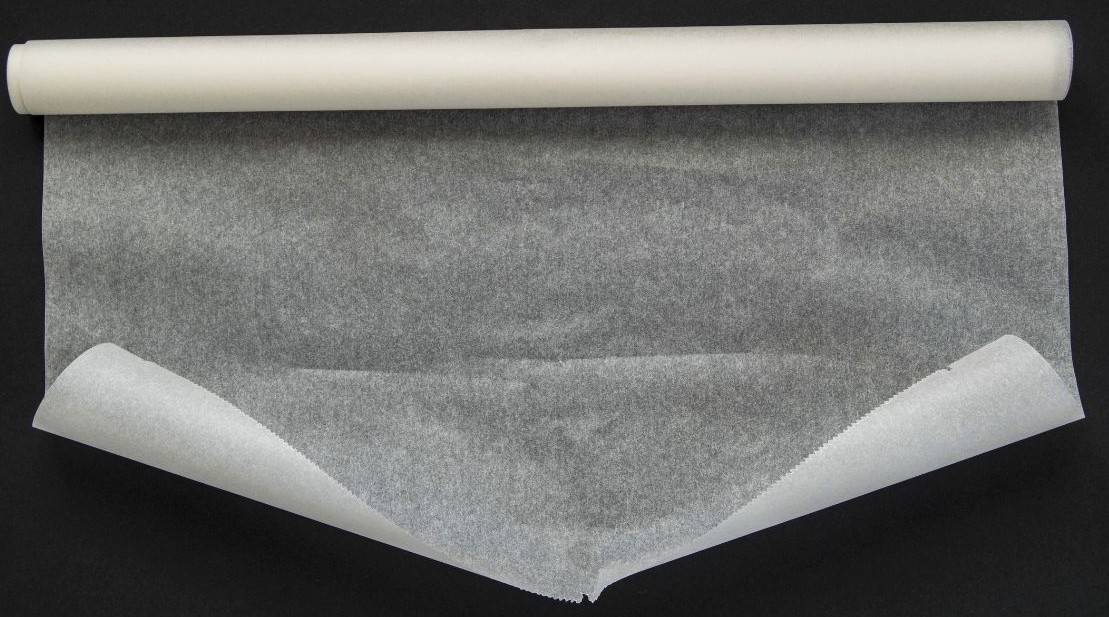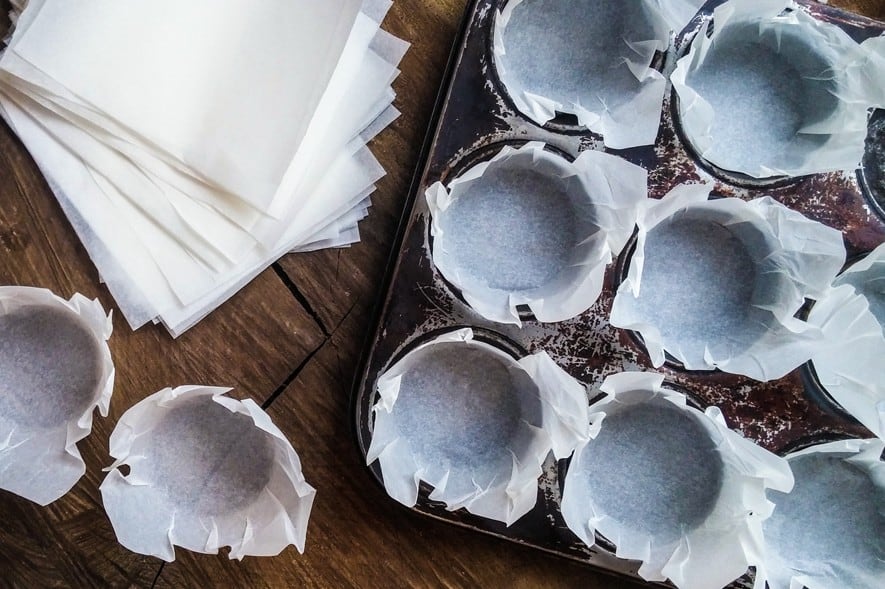Pastry chefs and people who have baking as one of their hobbies understand the struggles and frustrations of having the cookies or cake stick onto the pan and end up getting ruined. Therefore, it is essential that you know the tips and tricks on how to line a pan with parchment paper.
Things you will need to line a pan with parchment paper
There are only three important things you need for this process. These are primarily available in the kitchen if you are a baker, either by heart or profession.
Parchment Paper

As the name implies, parchment paper is a paper that has been coated with either Quilon or silicone, making it not sticky and resistant to both heat and water. It is famous for people who are into baking or pastry chefs.
Though, parchment paper is a versatile material because it can also be used for other purposes besides baking.
Basically, only two types of parchment paper are identified according to their color. First is the one that comes in a translucent white color. Thus, known as bleached parchment paper. On the other hand, the different type of parchment paper is called unbleached parchment paper, making it translucent tan in color.
A parchment paper is bought either in a rolled package or in pre-cut sheets that can fit any size of pans that are often used for baking.
Parchment paper is often available in cooking and baking stores, but you can also find it at the local grocery stores near you.
Baking Pan

A baking pan is cookware used to make pastries that require an oven due to the high heat involved. It’s the perfect equipment to use because it has a higher heat tolerance compared to ordinary pans.
The Baking pan comes in different materials, sizes, and shapes depending on which pastry you will bake.
Scissors
The sole purpose of scissors is to cut the parchment paper to fit into the baking pan.
How to line different types of pan with parchment paper?
Different types of pans are used in baking pastries. These pans vary according to their sizes, shapes, and use. Therefore, the process of lining a pan with parchment paper also differs. It usually depends on the type of pan you are going to use.
The final step of lining a pan varies depending on the pastry recipe you are following. It may require you to grease the parchment paper once again after you have lined it and sprinkle a generous amount of flour.
Some recipes only require lining the pan with parchment paper and do not necessitate additional greasing. Regardless, the aim is to release the baked goods without facing any troubles.
How to line a round cake pan with parchment paper
The purpose of lining a round cake pan with parchment paper is to prevent the cake from sticking onto the bottom surface of the pan while it bakes. Being able to line the pan correctly will help you release the cake quickly.
- Prepare parchment paper, regardless of whether it is Quilon or silicone. Use a pen and trace the circular shape of the round cake pan onto the parchment paper.
- Once you are done tracing the circle, get a pair of scissors and cut along the traced circular line.
- After doing the second step, grease the pan either with melted butter or spread a tiny amount of oil.
- The next step is to place the round-shaped parchment paper onto the pan and smoothen it flat.
How to line a cupcake or muffin pan with parchment paper

One of the easiest pans to line with parchment paper is the cupcake and muffin pan. Cupcake liners that come in various shapes, patterns, colors, and sizes are already available in the local baking store near you.
You no longer need to make your own unless you are in a rush and have no time to drop by the store. Then, you can create a DIY cupcake and muffin liner using parchment paper.
- Depending on how many cupcakes and muffin liners you need, cut the parchment paper that can cover all the sides from the bottom all the way to the top of the muffin pan. However, this can cost you a lot because you have to use an adequate size of parchment paper.
- Once you have already prepared many muffins and cupcake liners, you may start greasing the cup liner using oil or melted butter.
- Place the prepared muffin and cupcake liners into the greased pan and press them gently until they fit the mold.
How to line a loaf pan with parchment paper

Loaf pan usually comes in either square or rectangular sizes. The recommended method to line a loaf pan with parchment paper is the sling method.
It is called a sling method because parchment paper is placed on all the sides and bottom of the pan. Thus, you can have a clean release with a sling for easy transfer of the baked goods.
- Cut the parchment paper by the shape and size of the loaf pan.
- Please use metal clip binders instead of plastic ones to ensure that they are safe for the oven. The size of the metal clip binders varies depending on the thickness of the baking pan.
- Use cooking spray, melted butter, or cooking oil to grease the pan.
- Place the pre-cut parchment paper onto the pan and lay it flat, removing the air bubbles. Ensure that there are no creases as well.
- Once the parchment paper is fully intact with the bottom and all sides of the baking plan, attach the metal clip binder to the excess overhang parchment paper.
Watch the tutorial video below to learn how to grease a pan
How to line a baking sheet with parchment paper

A baking sheet is the easiest and simplest type of pan to line with parchment paper that even a seven-year-old kid can do.
- Get a parchment paper that is a little bigger than the actual size of your baking sheet.
- Place the parchment paper onto the baking sheet and lay it flat. To secure its placement, you can use a pair of scissors to press the excess parchment paper on all the edges of the baking sheet.
- Once you are done pressing it down, cut along the creases of all the excess parchment paper, then place it again.
- Do not forget to grease the pan using your preferred greaser, may it be a cooking spray or cooking oil.
Essential Tips and Tricks when lining a pan with parchment paper

You now have learned how to line different sizes and shapes of baking pans with parchment paper.
Ensure that you keep these essential tips and tricks in mind to help you avoid your pastries from sticking onto the pan ever again.
- There is a possibility that even if you have completely lined the pan with parchment paper, it can still move. So to ensure that it stays in place, you can spray a small amount of a non-stick cooking spray.
- If you are somewhat perfectionist and want to achieve perfect and neat edges, you may want to consider adding another sheet of parchment paper placed in an opposite direction.
- Make sure that the parchment paper is not peeking out of the baking pan because it can cause fire once it touches the interiors of the oven.
- Parchment papers are disposable. It is best if you avoid using it more than once.
- When storing the parchment paper, make sure that it is laid flat and not rolled so that the next time you use parchment paper, it will not roll back.
Recommended alternatives for parchment paper
Indeed, parchment paper is a versatile material. However, despite the advantages and functionality of this material, people still opt not to use it because it is disposable as it is a single-use item. Thus, making it costly. Moreover, it can also not be the best option for people who try to lessen their carbon footprint.
Parchment paper is environmentally-friendly and biodegradable, but it still requires substantial time and effort to compost fully.
Therefore, listed below are the recommended alternatives for parchment paper you can use the next time you bake:
Aluminum Foil

If you are also concerned about the environment, aluminum foil is ranked as the best alternative to line a pan. It is readily available and as functional as parchment paper, but aluminum foil can also be recycled.
Lining your pan with aluminum foil can also help prevent spillage and drips. However, as this is a glossy and smooth material, it lacks the non-stick properties a parchment paper has. Thus, to let it stick onto the pan, you are tasked to add more oil than your standard measurement.
Moreover, aluminum foil is reflective, meaning it reflects heat quickly. Therefore, the pastries you are baking will not take much longer before it is done.
Greased and Flour Pan

If you neither have parchment paper nor aluminum foil available in your household, you may opt to do the outdated method by greasing the pan then dusting with baking flour.
Cooking Spray

A cooking spray is also recommended as an alternative to parchment paper. It still does the same job as the parchment paper, which stops the baked goods from sticking onto the pan.
Cooking spray is readily available to the local store near you. Basically, it is just oil in a can. This is used by spraying an ample amount to the baking pan to make the surface non-stick. You no longer need to sprinkle a tremendous amount of flour onto the baking pan.
Silicone Baking Pad or Mat
![]()
Silicon baking pad or mat is also environmentally friendly as you can use it almost a thousand times because it is washable compared to disposable parchment paper. Therefore, it is also a recommended alternative to line a pan.
This baking pad is made out of high-quality and food-grade fiberglass and silicone. It has a non-stick surface and can withstand heat up to 428 degrees Fahrenheit. It comes in various shapes and sizes, which can fit regardless of the size of your baking pan.
Summary
Learning how to line a pan with parchment paper will not take much of the baker’s time. It will save you from ruining both your baked goods and the pan itself. The steps are easy to follow, and you will definitely not have difficulty removing your baked goods from the baking pan.


Michael Johnson is the founder of Pan Mastery, Inspired by his blacksmith grandfather’s legacy has a deep appreciation for hand-crafted pots and pans, he provides invaluable guides, reviews, and recipes to enhance your culinary journey.

Worried about carbon footprint, but not worried about the connection between aluminum and Alzheimer’s.